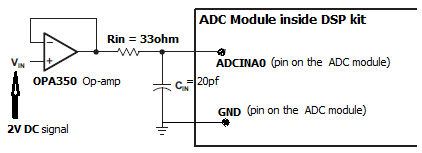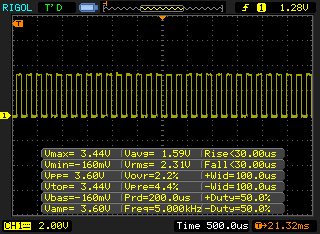Board: TMS320F2808
I have follow all the instruction manual of software & hardware to configure ADC module with external signal circuit.
For stable & low impedance signal, i used OPA350 opamp, Resister Rin=33ohm, Capacitor Cin=20PF as per the reference guide "Analog Interface With 28xx
DSCs SPRAAP6.PDF". Then fed this stable & low impedance signal across ADC module of [ADCINA0 & GND] pins and starting the operation of Debugging & Run. But in [ADCRESULT0] register bit printing/calculating random digital value, which is not equivalent to analog input value.
What should i do to generate appropriate digital value?
Am i missing any steps to configure ADC?
Here i'm inserting hardware configuration:
Here i'm including software configuration:
void init_adc(void)
{
AdcRegs.ADCTRL3.bit.ADCCLKPS = 2; // ADC Clock Pre scaler (i.e 12.5MHz)
AdcRegs.ADCTRL3.bit.SMODE_SEL = 0; // Sequential model
AdcRegs.ADCMAXCONV.all = 0; // 1 Conv's on SEQ
AdcRegs.ADCCHSELSEQ1.bit.CONV00 = 0; // Setup ADCINA0 as 1st SEQ Conv.
AdcRegs.ADCTRL1.bit.SEQ_CASC = 1; // Cascaded Sequencer Mode
AdcRegs.ADCTRL1.bit.SEQ_OVRD = 0; // disable SEQ overriding mode
AdcRegs.ADCTRL1.bit.CONT_RUN = 1; // Continuous Run mode
AdcRegs.ADCTRL1.bit.CPS = 0; // divide by 1
AdcRegs.ADCTRL1.bit.ACQ_PS = 7; // S/H=(1+ACQ_PS)*(time of ADCCLK)
AdcRegs.ADCTRL1.bit.SUSMOD = 0; // Emulation suspend is ignored
AdcRegs.ADCTRL2.bit.RST_SEQ1 = 0; // No action
AdcRegs.ADCTRL2.bit.EPWM_SOCA_SEQ1 = 1; // SEQ1 start from ePWM_SOCA trigger
AdcRegs.ADCTRL2.bit.INT_ENA_SEQ1 = 1; // Enable SEQ1 interrupt request to CPU
AdcRegs.ADCTRL2.bit.INT_MOD_SEQ1 = 0; // Interrupt after every end of sequence
}
__interrupt void adc_isr(void)
{
unsigned int t;
unsigned int V[200];
for(t=0;t<10;t++)
{
V[t] = AdcRegs.ADCRESULT0; // Stores Digital value
printf("Digital Voltage: V[t]= %u \n", V[t]);
}
AdcRegs.ADCST.bit.INT_SEQ1_CLR = 1; // Clear INT SEQ1 bit
AdcRegs.ADCTRL2.bit.INT_ENA_SEQ1 = 0; // Disable SEQ1 interrupt
PieCtrlRegs.PIEACK.all = PIEACK_GROUP1; // Acknowledge interrupt to PIE
return;
}




